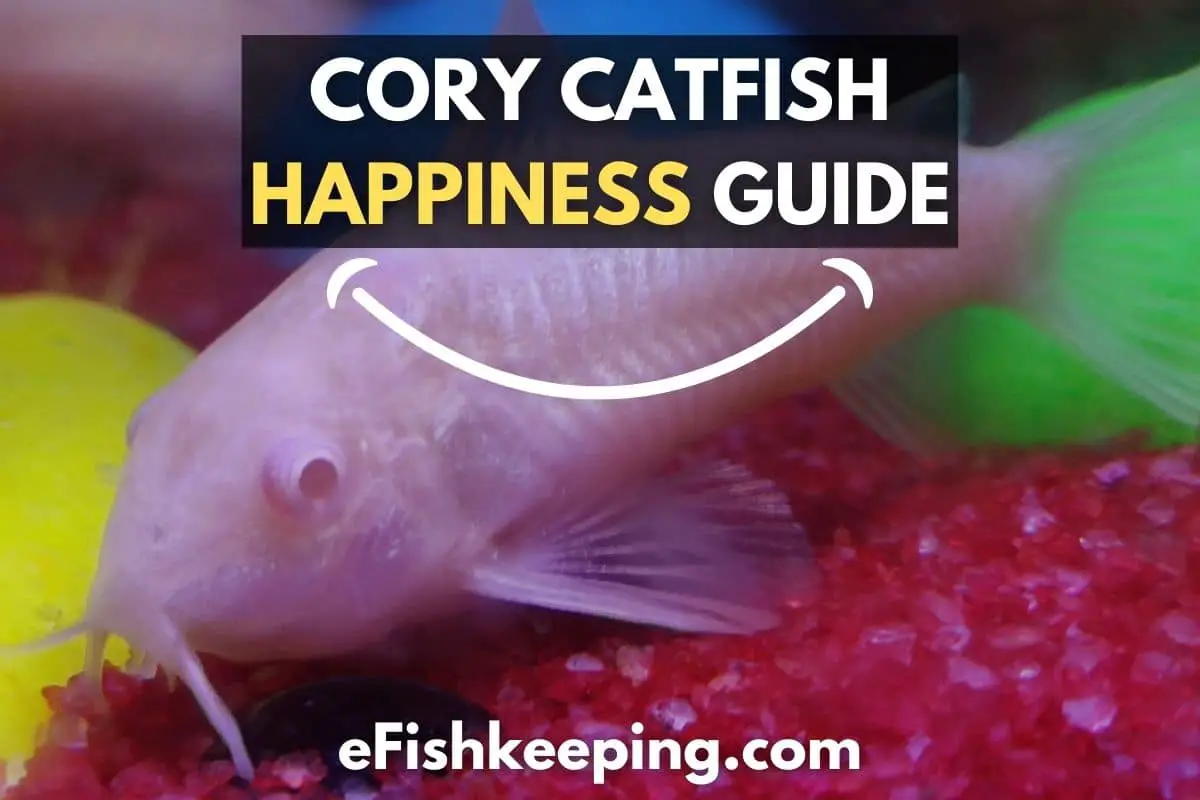So you have cute cory catfish in your fish tank like me? But not sure whether they are happy or not? Don’t worry, I get you and you are exactly in the right place!
Continue reading till the end to learn if your Cory Catfish are happy, how to know if they’re stressed, as well as the best tips to make them happy.
Are My Cory Catfish Happy?
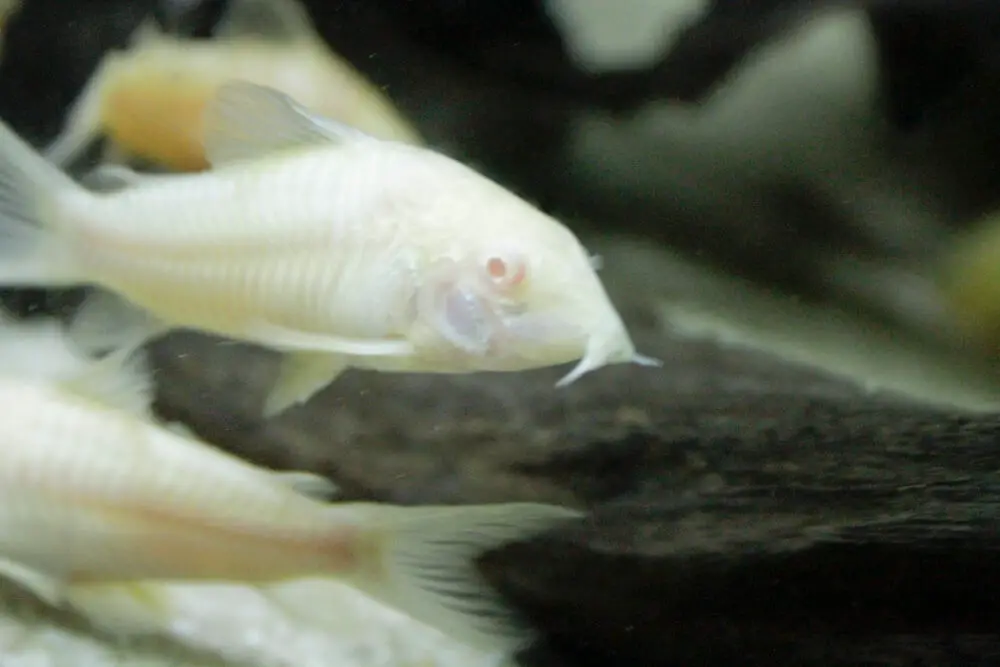
When kept alone, Cory Catfish are often unhappy. Cory catfish should always be kept in groups of 5 or more to keep them happy.
When adequately fed, maintained, and given the correct amount of space and friends, their schooling antics are not only considered entertaining to watch, but they also aid in helping owners distinguish the happiness of their catfish.
What Is Normal Behavior for a Cory Catfish?
Cory Catfish are known for their quiet, serene, easy, and non-aggressive demeanor. However, there are several different kinds of Cory Catfish, and some are more cautious and more timid than others. This shift in behavior might be due to their relative size to the other fish in the tank. It might also be connected to the tank’s overall dynamics.
They are shoaling fish, which means they reside in a massive group with other members of their species. Cories in the wild feed for microscopic insects, larvae, and worms on the river or pond bottom.
If you have an albino cory catfish then I would recommend you to have a look at my complete guide to what albino cory catfish eat here.
Cory Catfish are known for being active during the day, but they may also be seen sitting quietly in the same area at night. Even though Corys move around the tank at night, they appear to be more active during the day.
Cory Catfish evolved to possess a labyrinth organ that allows them to shoot up from the bottom of the tank and suck air from the surface when necessary. This enables Corys to survive short periods in low-oxygen environments in the wild.
Read Also: Cory Catfish Not Moving? Top 7 Possible Reasons!
How To Know If Your Cory Catfish Is Happy?
You should monitor your Cory Catfish’s behavior to establish if they are happy and healthy. If your Cory is energized, animated, and hungry, it is likely that they are in good spirits and enjoying life. If you’re concerned about your Cory because they’re swimming slower or more erratically, their hunger has decreased, or they look to be gasping for breath, your Cory is stressed.
Odd swimming patterns, such as swimming upside down, lethargy, a refusal to feed, a change in look, and fast gill movement are all indicators of stress in your Cory Catfish.
If your Cory Catfish displays one or more of these symptoms, it may be stressed due to bad tank conditions, inadequate acclimation, loneliness, overcrowding, or a shortage of food.
One should act as soon as possible to prevent their fish from becoming unwell or dying.
What Are the Signs of a Happy Cory Catfish?
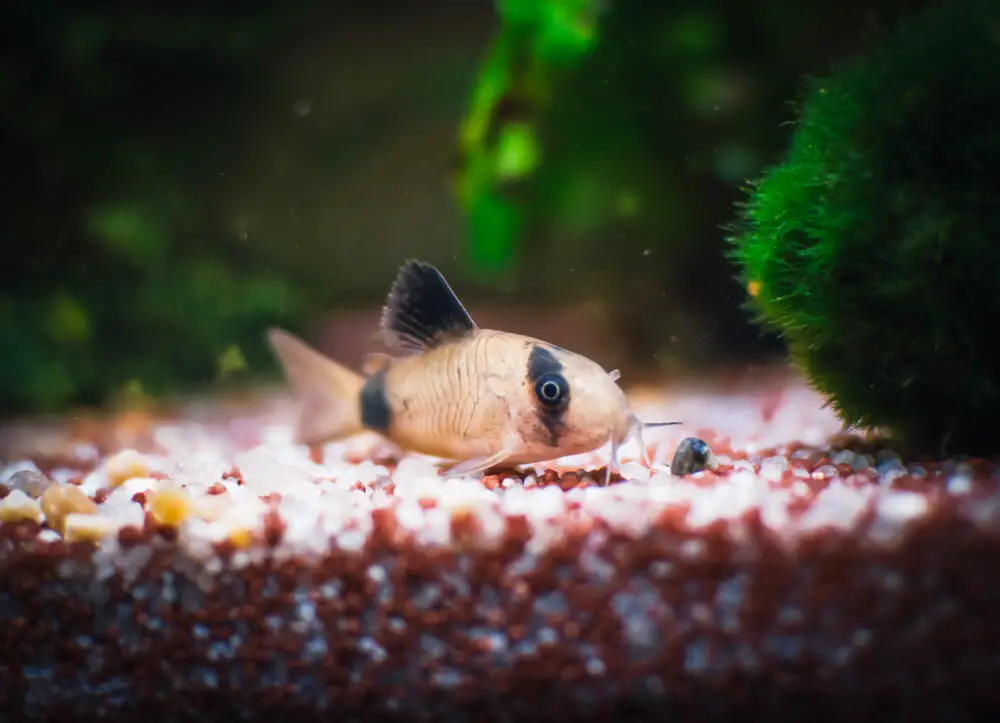
1. Reading Your Cory Catfish’s Swimming Patterns to Determine if They’re Happy
A happy, healthy Cory Catfish will uniquely dance around the tank. In schools, these fish tend to stay together at most times. If you notice your Cory off and alone in your tank, this can signify that they are unhappy or lonely.
Erratic swimming behavior in aquarium fish, such as Cory Catfish, can be based on a variety of abnormal movements.
If your Cory begins darting, corkscrew swimming, swimming up and down, occasionally floating to the surface, swimming in circles, sinking to the bottom, or swimming sideways or upside down, this is the strongest indicator of stress in your fish.
Read Also: Why Is My Cory Catfish Swimming Crazy?
Stress, ammonia poisoning, poor water quality, and swim bladder illness are the most prevalent causes of aquarium fish swimming erratically.
2. Reading Your Cory Catfish’s Behaviour to Determine if They’re Happy
Cory Catfish are considered one of the most desirable fish in the hobby when it comes to temperament. It’s almost adorable how tranquil and calm they are.
Cory Catfish can also get along with almost any other species. However, since they are non-aggressive and rarely stand up for themselves, they should not be kept with aggressive tank mates.
However, don’t assume that a Cory Catfish’s demeanor indicates they’re uninteresting. At all hours of the day, Cory Catfish are active and enjoyable to watch.
Cory Catfish are highly sociable fish that should be kept in at least groups of five. Observing your Corys interact with one another is unlike any other leisure fish.
If you find that your Cory Catfish begins to act estranged from its tank mates or act more reserved, this could indicate stress in your fish.
3. Reading Your Cory Catfish’s Appetite to Determine if They’re Happy
As typical bottom feeders and scavengers, Cory Catfish devour a variety of debris, including rotting plant material and uneaten fish food. Your Cory should have a decent appetite. Therefore, small insects and crustaceans can also be added to their tank as an extra snack to be eaten by these fish.
Known as easy fish, you should not have to convince your Cory to eat. If you notice that your Cory Catfish’s eating patterns have changed, this could indicate stress or illness. Before becoming too concerned, try switching up your Cory’s diet to see if they are just being picky.
Cory Catfish can also be fed sinking wafers or pellets, Shrimp Pellets, Aqueon Bottom Feeder Tablets, Tropical Granules, and Algae Rounds, as well as some live and frozen items as a supplemental diet in their home aquarium.
Recommended Read: Will Cory Catfish Eat Algae Wafers?
Your Cory Catfish, like most tropical fish species, should be fed simply enough food to devour in three minutes. It’s best to do this twice a day. When feeding your fish one serving every day, give them as much as they can eat in five minutes.
How Do You Know If a Cory Catfish Is Stressed?
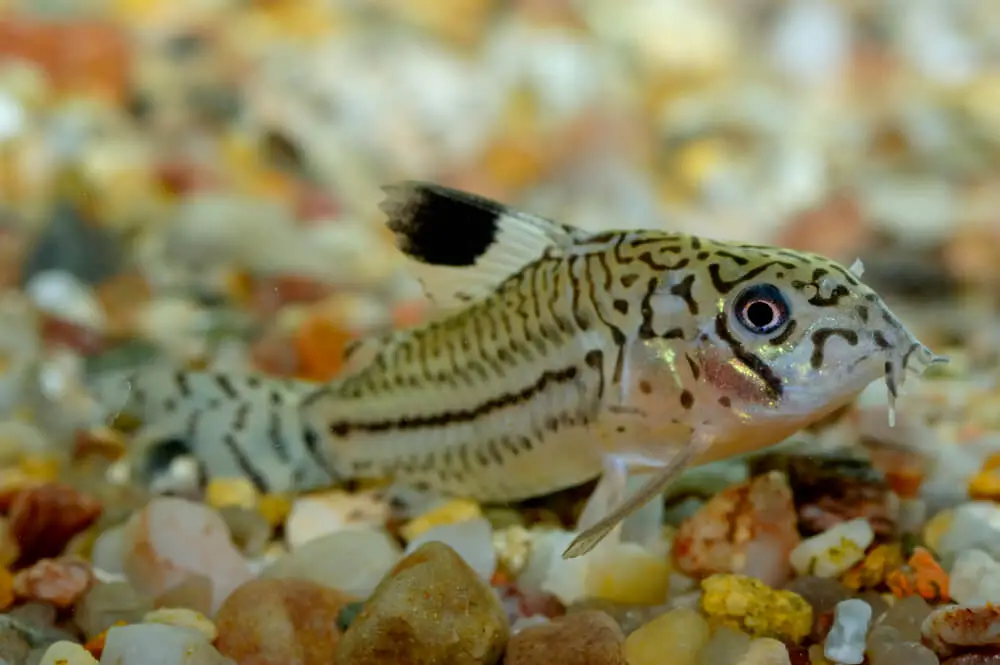
Since we, unfortunately, don’t speak fish, Cory Catfish will show you through their behavior and appearance whether they are stressed or not. Whether your Cory starts swimming erratically, loses its appetite, or starts appearing different, one must determine the cause of their Cory’s stress to find a solution.
1. Reading Your Cory Catfish’s Swimming Patterns to Determine if They’re Stressed
When Cory Catfish are agitated, their swimming patterns can become strange. Your Cory Catfish may be stressed if they are swimming wildly without going anywhere, smashing at the bottom of the tank, rubbing themselves on gravel or pebbles, or locking their fins at their side.
If you notice your Cory swimming in these weird patterns, you need to identify the cause of their stress, whether it’s loneliness, overcrowding, or more. Erratic swimming patterns from one of your Cory Catfish can quickly become a problem in your tank since they may crash into or injure your other fish.
2. Changes in Your Cory Catfish’s Appearance Can Indicate Stress
Keep an eye on the appearance of your Cory to determine if they are happy. If your Cory Catfish starts to discolor and become pale in color, or if white areas on their body or gills get discolored, this can be a strong indicator that they are stressed.
Cory catfish typically appear to have a short face and a flat underbelly. They have pectoral fins that jut out and rest on the surface, and they frequently use them to support themselves up. The dorsal fins of certain types tip upwards like a sail, while others have more rounded fins.
Any discoloration or white areas on your fish are indications that they are unhappy. Whether it’s because they’re lonely, their water parameters are off, they’re overcrowded, or anything else, in order to restore your Cory Catfish’s natural beauty, you’ll need to discover out what’s upsetting them.
3. Reading Your Cory Catfish’s Appetite to Determine if They’re Stressed
Cory Catfish typically have a pretty strong appetite. Therefore, if your Cory suddenly starts eating dramatically less or becomes more picky with their food, this could be an indication of stress in your fish.
Corys cease eating for various reasons, the most prevalent of which is poor water quality. Changes in pH balance and toxins in the water are both harmful to fish. Keep in mind that fish eat, swim, pee, and defecate in the same body of water. As a result, if the water is not changed regularly, things can quickly become unpleasant.
Since ammonia is one of the compounds present in fish urine, and when its levels grow too high, it makes your Cory Catfish feel unpleasant, your fish will stop feeding if the water quality becomes terrible enough.
Your Cory may also stop eating if they are lonely. If you don’t have a big enough school and enough friends for your Cory Catfish to play with, they may stop eating, which could eventually make them sick.
How Do I Keep My Corys Happy?
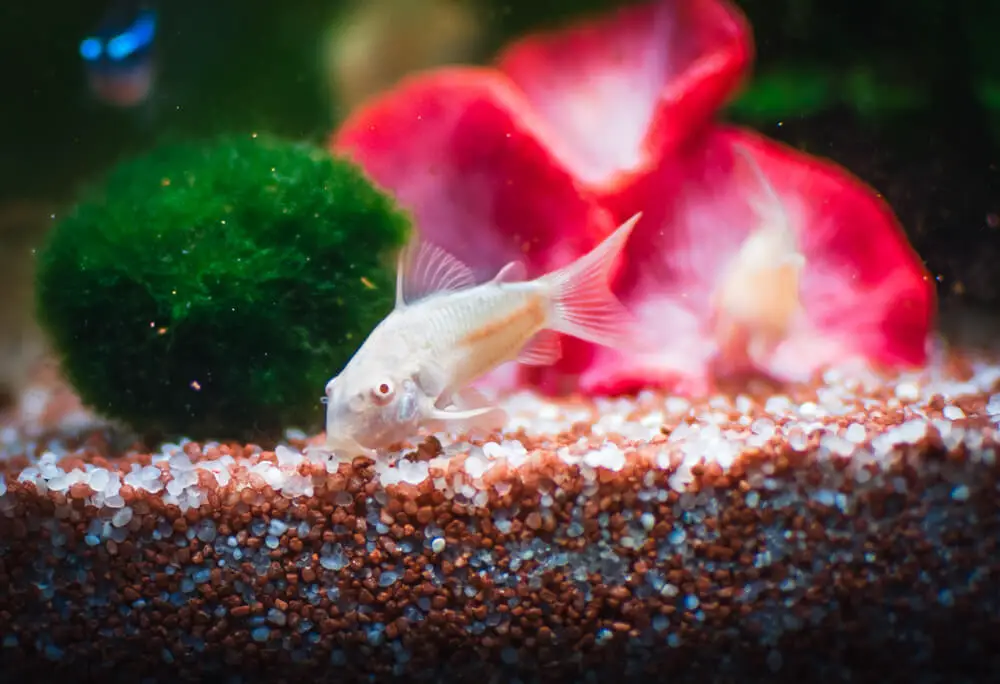
Keeping your Cory Catfish happy is a simple task as long as you have the proper knowledge at hand. As long as you provide your Cory with adequate socialization, space, diet, and water parameters, you can easily give them the happiness they deserve.
1. Keeping Your Cory Catfish with Other Cory Catfish
Cory Catfish are very gregarious animals, especially within their own species.
While Cory Cats may survive independently, they appear to thrive in groups of two or more. One will see happy Corys roaming around the tank together. This is particularly true while they are sleeping.
Other Cory Catfish are usually always visible an inch or two distant when one Cory takes a rest in the corner of a tank.
Two distinct varieties of Cory Catfish may act in the same way. Corys of the same kind, on the other hand, appear to cling together the most.
It is critical to keep Cory catfish in groups of four or more fish. However, housing five or more of these fish is the preferred option if you have the tank space.
Their schooling antics are not only entertaining to watch, but they also aid in displaying to their owners their overall happiness and health level.
If you keep your Cory Catfish in a school but notice that they are not interacting and playing like the others, that particular Cory may be sick or unhappy.
By the way, are you confused about how many corys to keep together or about their tank size? Then I highly recommend you to check out the following two helpful guides:
- How Many Cory Catfish Should Be Kept Together?
- Cory Catfish Tank Size: A Complete Guide (+ Infographic)
2. Avoid Overcrowding Your Cory Catfish’s Tank
Cory Catfish, as previously said, are a gregarious species that enjoys being kept in schools. However, it is normal for them to lose their passion due to frustration and despair when they are overloaded. If you have a fifteen-gallon tank and no other large aquatic pets, a school of six is ideal.
Since Corys are schooling fish, if you want to keep a school of more than six Cory Catfish, you’ll need to increase the size of your tank. A 30-gallon tank, for example, would be ideal for larger schools.
3. Keep Your Cory Catfish’s Water Parameters in Check
When it comes to water quality, wild-caught Cory catfish are known to be finicky. However, selective breeding has hardened tank-bred Cory catfish into an extraordinarily durable and resistant species over the years.
Although Corys aren’t tough to keep, every effort should be taken to give them with a stable habitat.
A pH of 6.0-8.0, a temperature of 70-80 degrees Fahrenheit, and alkalinity of 3-10 should be maintained at all times in your Cory Catfish tank.
On the other hand, wild-caught Corys may require a pH of 5.5 to 7.0 and an alkalinity of less than 3.
Read Also: Do Cory Catfish Need A Heater?
These fish have a proclivity for darting to the surface and catching a breath. If they do it a few times a day, it’s perfectly natural.
However, if you notice your Cory taking breaths from the surface several times every day, it suggests that your aquarium’s water quality is poor.
4. Provide Your Cory Catfish with an Adequate Diet
Cory Catfish, like any other bottom feeder, are superb scavengers. They frequently locate the bulk of their food scouring the tank bottom in communal aquariums. However, owners of Cory catfish should never think that leftover scraps are enough to feed their fish.
Since Cory Catfish are omnivores, they should be fed a varied diet that includes both plant-based and meat-based meals.
Make sure you don’t overfeed Cory Catfish since they are sensitive to nitrite, ammonia, and nitrate fluctuations. Feed your Cory only as much as they can consume in three minutes, and discard whatever they don’t appear to enjoy.
What Is the Ideal Tank Environment for a Happy Cory Catfish?
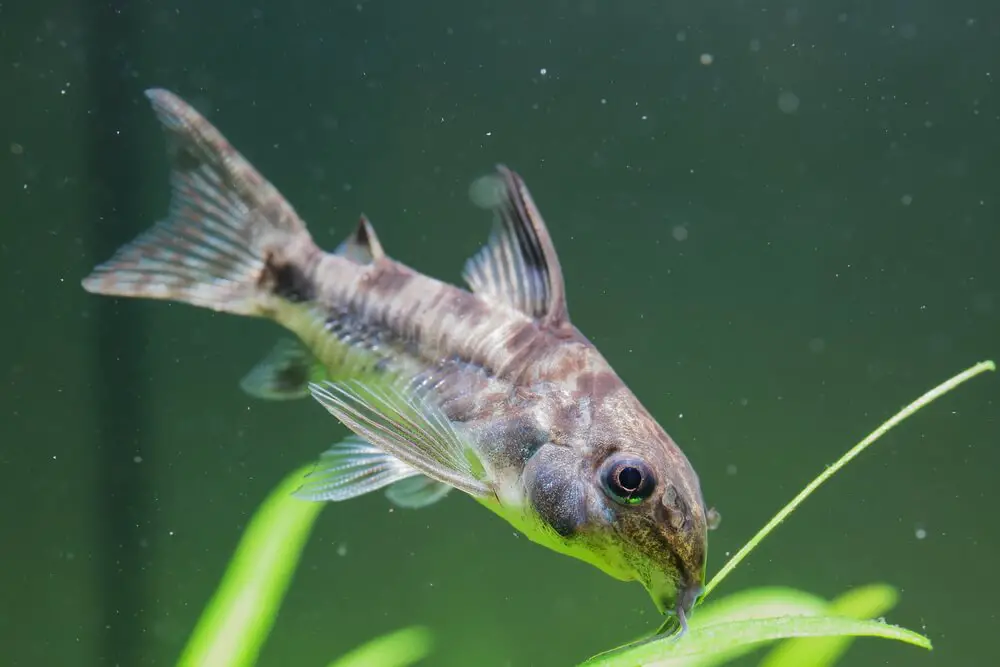
1. Keeping the Tank Clean Can Help Keep Your Cory Catfish Happy and Healthy
Cory fish require an excellent environment to thrive. Your Cory tank will need to be cleaned once a week to ensure they are constantly provided with the best environment possible. This involves cleaning the aquarium glass and vacuuming extra waste from the gravel.
Your Cory Catfish will frequently hide while you clean but will usually reappear once you are done. Stressing them might cause them to emit chemicals that can kill other fish, so be careful.
Water changes are also required on a weekly basis. When you change the water, you should attempt only to change approximately 20% of the water. When replacing the water in your tank, ensure the freshwater is dechlorinated before pouring it in, as disrupting the substrate might cause ammonia surges.
2. Environmental Factors to Keep Your Cory Catfish Happy
Since Cory Catfish are tropical fish, they demand warmer waters at roughly 70-78°F. The temperature must also be steady, as extreme variations might lead to stress unless you are aiming to stimulate breeding.
High nitrate levels are also known to cause stress in Cory Catfish, so test the water regularly and keep it at 0ppm. Barbel infections can be caused by stress, so keep an eye on your water quality as well as their behavior.
Soft sediments, ideally sand, are required for Cory Catfish. However, tiny, rounded stones can be utilized as a substrate. If the gravel is sharp, wounds and infections might result. Cory prefer slower-moving streams and inlets since this protects them from the fast-moving water. This should be mirrored in the aquarium by turning down the filter’s power.
A planted aquarium will also help break up the water flow while also oxygenating the water and offering shade from the sun. Amazon swords, penny warts, crypts, and dwarf hairgrass are among the plants to consider incorporating in your Cory Catfish tank.
Final Thoughts
Cory Catfish are quite simple to keep as long as they have everything they require. Proper tank parameters, lots of food, companions, and tank space are all essential. Pay attention to signs of stress, illness, or unhappiness if you notice them swimming crazily and frantically.
Measure the water parameters and watch the behavior of all aquatic life in your delicate ecosystem to make sure your tank isn’t the source of the problem.
If you feel like your Cory is lonely, get them some friends. Since most peaceful species can cohabitate with your Cory Catfish, this is probably the easiest way to entertain and keep your Cory happy.
Overall, if you think you’re giving your Cory Catfish everything it needs and it still seems unhappy and depressed, see a veterinarian to inquire if they can assist you. If your veterinarian has aquatic pet experience, you will most likely need to provide them with a water sample from your Cory’s tank to help them run some diagnostic tests.
Read Next:
- Are Cory Catfish Hardy? What Are The Hardiest Cory Catfish?
- Do Cory Catfish Need Bubbler? Do They Prefer Water Current?
Hi! I’m Praveen Ghoshal, the founder of eFishkeeping.com. Inspired by my Dad, I got interested in fishkeeping when I was a kid. Since then, I have been involved with this hobby. Currently, I have 3 fish tanks at our home, and I enjoy this hobby with my full family. Read more about me here.

